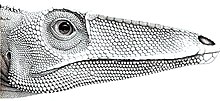Megapnosaurus (version 2)
| Megapnosaurus Temporal range: Early Jurassic
| |
|---|---|

| |
| An artist's depiction of Megapnosaurus kayentakatae. | |
| Scientific classification | |
| Kingdom: | |
| Phylum: | |
| Class: | |
| Superorder: | |
| Order: | |
| Suborder: | |
| Family: | |
| Genus: | Megapnosaurus Ivie, Slipinski & Wegrzynowicz, 2001
|
| Species | |
|
M. rhodesiensis (Raath, 1969 [originally Syntarsus]) (type) | |
| Synonyms | |
|
Syntarsus Raath, 1969 (preoccupied by Fairmaire, 1869) | |
Megapnosaurus (meaning "big dead lizard", from Greek μεγα = "big", 'απνοος = "not breathing", "dead", σαυρος = "lizard") was a dinosaur of the theropod family Coelophysidae, formerly called Syntarsus (named by Raath, 1969), living during the Early Jurassic. It was renamed by American entomologist Dr. Michael Ivie (Montana State University of Bozeman), Polish Australian Dr. Adam Ślipiński, and Polish Dr. Piotr Węgrzynowicz (Muzeum Ewolucji Instytutu Zoologii PAN of Warsaw), the scientists who discovered that the genus name Syntarsus was already taken by a colydiine beetle described in 1869. Some paleontologists did not like the name Megapnosaurus, but it remains the valid name for this genus.
It is almost identical to Coelophysis, and Yates (2005) suggested that Megapnosaurus was possibly synonymous with Coelophysis.[1] In 2004, Raath co-authored two papers in which he argued that "Syntarsus" (Raath continued to use the old, invalid, name) was a junior synonym of Coelophysis.
Megapnosaurus measured up to 3 meters (10 ft) long from nose to tail and weighed about 32 kilograms (70 lb). The bones of 30 Megapnosaurus individuals were found together in a fossil bed in Zimbabwe, so paleontologists think it may have hunted in packs. The various fossils attributed to Megapnosaurus have been dated over a relatively large time span- the Hettangian, Sinemurian, and Pliensbachian stages of the Early Jurassic- meaning the fossils represent either a highly successful genus or a few closely related animals all currently assigned to Megapnosaurus.
Megapnosaurus is a good example of how dinosaurs spread across the globe from their ancestral habitats (which was possibly South America). This small predator had the same basic features found in early dinosaurs, and its appearance in both Africa and the southwestern U.S. indicate that it migrated through the continents, which at the time were joined together as Pangaea. There is species-level differentiation between the African and U.S. specimens, again supporting the migration and adaptation theories.

The African species (M. rhodesiensis) is known from almost 30 specimens. The North American species (M. kayentakatae) had small crests and may show an evolutionary step toward the much larger coelophysoids, such as Dilophosaurus. Like Dilophosaurus, they are both members of the infraorder Ceratosauria (Coelophysoidea as a clade of this group is under serious debate recently, and most evidence points for a divergence of Coelophysoidea from Ceratosauria so that Ceratosauria is closer to Tetanurae), and in the family Coelophysidae. They also both possess a weak joint between the premaxillary and the maxillary bones, creating a hooked premaxillary jaw. This led to the early hypothesis that dinosaurs such as these were scavengers, as the front teeth and bone structure were thought to be too weak to take down and hold struggling prey.
Age determination studies using growth ring counts suggest that the longevity of Megapnosaurus was approximately 7 years.[2]
In popular culture
In When Dinosaurs Roamed America, a pack of Megapnosaurus (referred to as Syntarsus) attack an Anchisaurus, only to be scared off by a Dilophosaurus.
References
- ^ Yates, A.M. (2005). "A new theropod dinosaur from the Early Jurassic of South Africa and its implications for the early evolution of theropods". Palaeontologia Africana 41:105-122
- ^ Chinsamy, A. (1994). Dinosaur bone histology: Implications and inferences. In Dino Fest (G. D. Rosenburg and D. L. Wolberg, Eds.), pp. 213-227. The Palentological Society, Department of Geological Sciences, Univ. of Tennesse, Knoxville.
- Bristowe, A. & M.A. Raath (2004). "A juvenile coelophysoid skull from the Early Jurassic of Zimbabwe, and the synonymy of Coelophysis and Syntarsus." Palaeont. Afr., 40: 31-41.
- Bristowe, A., A. Parrott, J. Hack, M. Pencharz & M. Raath (2004). "A non-destructive investigation of the skull of the small theropod dinosaur, Coelophysis rhodesiensis, using CT scans and rapid prototyping." Palaeont. Afr. 40: 159-163.
- Ivie, M. A., S. A. Slipinski, and P. Wegrzynowicz (2001). "Generic homonyms in the Colydiinae (Coleoptera: Zopheridae)." Insecta Mudi, 15:63-64.
- Raath (1969). "A new Coelurosaurian dinosaur from the Forest Sandstone of Rhodesia." Arnoldia Rhodesia. 4 (28): 1-25.
